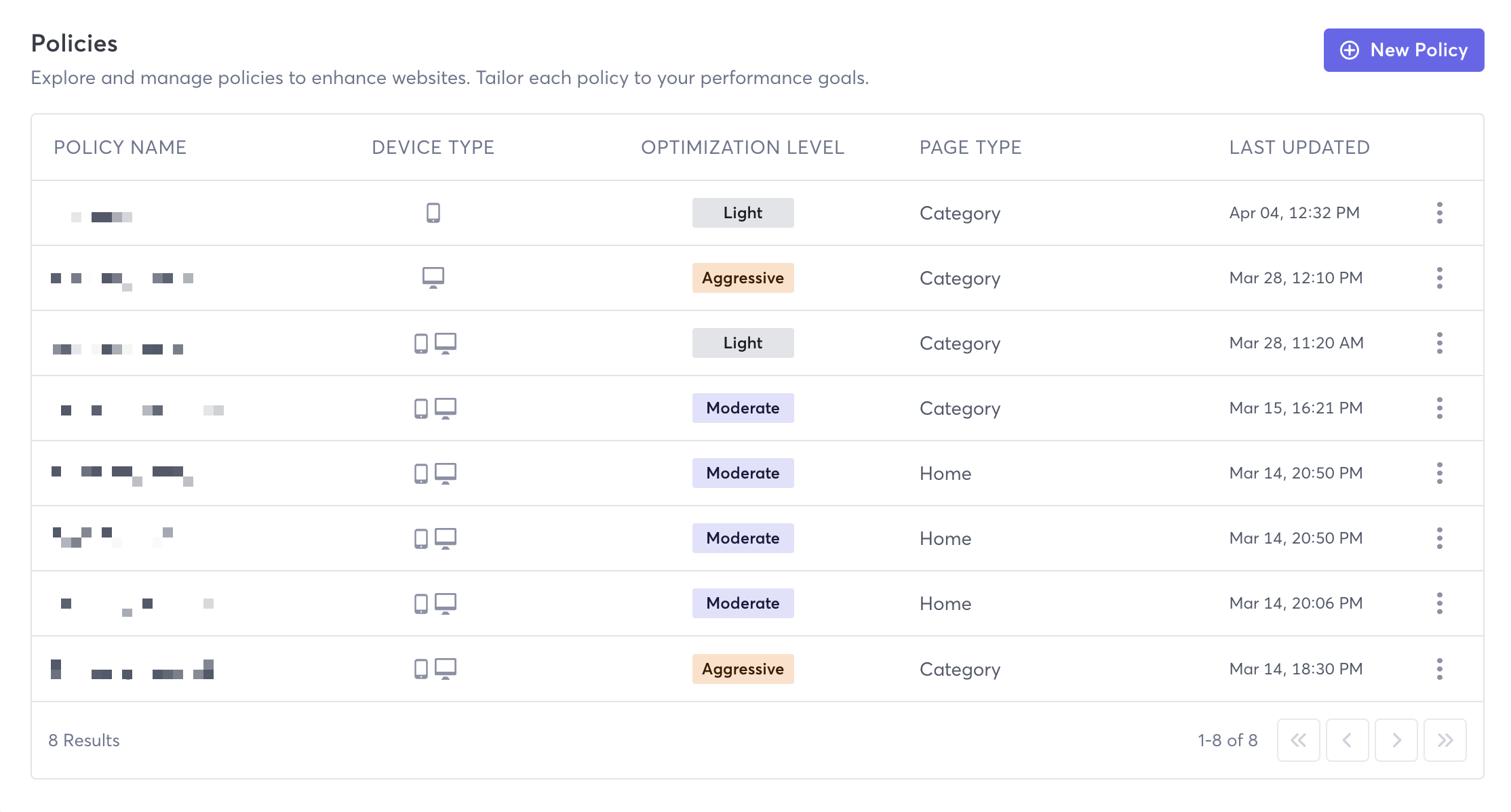Manage P3 Policies
A PhotonIQ Performance Proxy (P3) policy is a set of optimization rules applied to a set of origin URLs. This page explains how to perform tasks pertaining to P3 policies.
Policy Fields
P3 provides the following policy fields:
- Policy Name - The name of the policy.
- Device Type - Icons indicate whether the policy applies to mobile devices, desktop devices, or both.
- Optimization Level - The selected optimization level: Light, Moderate, or Aggressive.
- Page Type - Whether the type of optimization is for page type Home, Category, or Product Detail Page.
- Last Updated - The day and time this policy was last updated.

View Policies
Perform the following steps to view existing P3 policies on your account:
- Log in to your PhotonIQ Performance Proxy dashboard.
- Click Policies.
- (Optional) To view details of a policy, click the stacked dots next to the policy that you want to view and then click Edit.
Create a Policy
Perform the following steps to create a new P3 policy:
Log in to your PhotonIQ Performance Proxy dashboard.
Click Policies.
Click New Policy.
Enter information in the following fields. All fields are required.
- Name - The name of the policy.
- Origin - The URL the policy should be applied to.
- Target Region - The region where the origin is hosted and where to serve content from. Options are specific to each user.
- Is Region-Specific Content? - Select Yes or No.
- Is Origin Content Compressed? - Indicate whether the origin content is compressed or not.
- Device Type - Select what type of devices the policy should apply to.
- All (default)
- Desktop
- Mobile
- Tablet
- Optimization Level - Select what level of optimization P3 applies to the URLs in the policy. Each selection selects different optimizations:
- Light (default)
- Moderate
- Aggressive
- Page Type - Select what type of pages are being optimized. This affects which optimization rules that P3 applies:
- Home
- Category
- Product Detail Page
- Enable Policy - Turn the policy on or off. If the policy is enabled, then optimization rules are applied to incoming requests.
- Headers - If you want to pass headers to the origin, add as many headers as necessary.
- Send headers to origin - Select the checkbox to send the headers to the origin along with the request.
- Key - Header key.
- Value - Header value.
- mPulse Variable - Variable for tracking the policy in the mPulse dashboard.
- URL Pattern - Provide an absolute URL or a regex pattern in order to group pages that have the same structure.
- For example, you could list each page:or provide regex:
- /us/category/boys
- /us/category/girls
- /us/product/shoes
- /us/product/jeansThe remainder of the fields cannot be manually edited. They automatically toggle based on the selected Optimization Level. For more information about what each optimization does, refer to P3 Optimizations.- ^/us/category/.*$
- ^/us/product/.*$
- For example, you could list each page:
Edit a Policy
Perform the following steps to edit a P3 policy:
- Log in to your PhotonIQ Performance Proxy dashboard.
- Click Policies.
- Click the stacked dots next to the policy that you want to edit and then click Edit.
- Make any desired changes and then click Update.
Delete a Policy
Deleting a policy cannot be undone.
- Log in to your PhotonIQ Performance Proxy dashboard.
- Click Policies.
- Click the stacked dots next to the policy that you want to edit and then click Delete.
- To confirm your choice, click Remove.